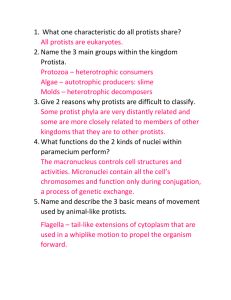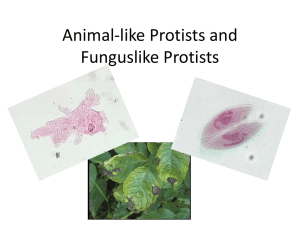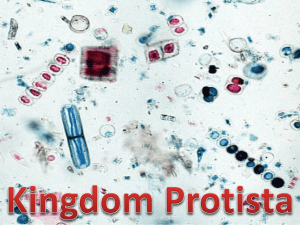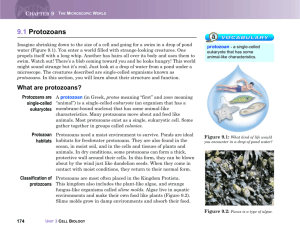Super Group
advertisement
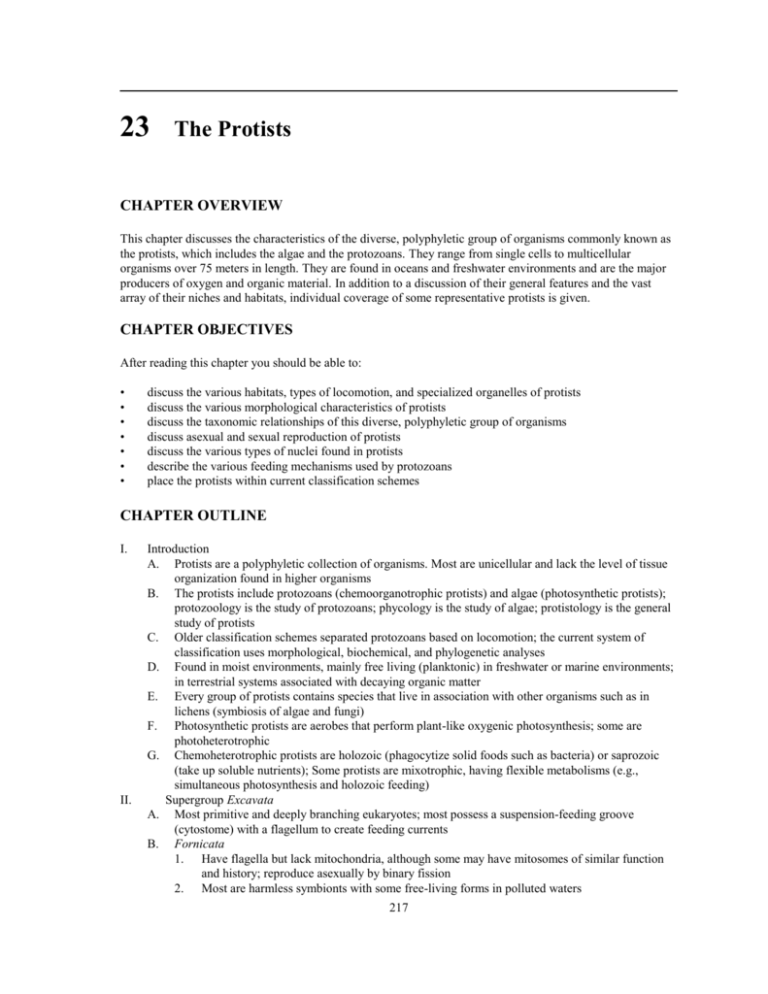
23 The Protists CHAPTER OVERVIEW This chapter discusses the characteristics of the diverse, polyphyletic group of organisms commonly known as the protists, which includes the algae and the protozoans. They range from single cells to multicellular organisms over 75 meters in length. They are found in oceans and freshwater environments and are the major producers of oxygen and organic material. In addition to a discussion of their general features and the vast array of their niches and habitats, individual coverage of some representative protists is given. CHAPTER OBJECTIVES After reading this chapter you should be able to: • • • • • • • discuss the various habitats, types of locomotion, and specialized organelles of protists discuss the various morphological characteristics of protists discuss the taxonomic relationships of this diverse, polyphyletic group of organisms discuss asexual and sexual reproduction of protists discuss the various types of nuclei found in protists describe the various feeding mechanisms used by protozoans place the protists within current classification schemes CHAPTER OUTLINE I. II. Introduction A. Protists are a polyphyletic collection of organisms. Most are unicellular and lack the level of tissue organization found in higher organisms B. The protists include protozoans (chemoorganotrophic protists) and algae (photosynthetic protists); protozoology is the study of protozoans; phycology is the study of algae; protistology is the general study of protists C. Older classification schemes separated protozoans based on locomotion; the current system of classification uses morphological, biochemical, and phylogenetic analyses D. Found in moist environments, mainly free living (planktonic) in freshwater or marine environments; in terrestrial systems associated with decaying organic matter E. Every group of protists contains species that live in association with other organisms such as in lichens (symbiosis of algae and fungi) F. Photosynthetic protists are aerobes that perform plant-like oxygenic photosynthesis; some are photoheterotrophic G. Chemoheterotrophic protists are holozoic (phagocytize solid foods such as bacteria) or saprozoic (take up soluble nutrients); Some protists are mixotrophic, having flexible metabolisms (e.g., simultaneous photosynthesis and holozoic feeding) Supergroup Excavata A. Most primitive and deeply branching eukaryotes; most possess a suspension-feeding groove (cytostome) with a flagellum to create feeding currents B. Fornicata 1. Have flagella but lack mitochondria, although some may have mitosomes of similar function and history; reproduce asexually by binary fission 2. Most are harmless symbionts with some free-living forms in polluted waters 217 3. C. D. III. A. B. C. D. E. F. Can be parasites in fish, pathogens in turkeys, and Giardia in humans causes diarrhea and is a public health concern Parabasilia 1. Flagellated, but without a distinct cytostome; use phagocytosis for feeding; most are endosymbionts of animals 2. Trichonymphida a. Obligate mutualist in the digestive tract of wood-eating insects (termites) b. Secrete cellulase to aid animal digestion c. Usually asexual but sometimes reproduce sexually in response to host hormone called ecdysone 3. Trichomonadida a. Anaerobic, do not contain mitochondria, but have hydrogenosomes, and reproduce asexually b. Symbionts of digestive, reproductive, and respiratory tracts of vertebrates i. Tritrichomonas foetus can cause spontaneous abortion in cattle ii. Dientamoeba fragilis causes diarrhea in humans iii. Trichomonas vaginalis can cause disease in human genitourinary tract Euglenozoa 1. Commonly found in freshwater, but can be marine 2. Some are photoautotrophic, while the majority are mainly saprotrophic chemoorganotrophs 3. Euglena is the representative photoautotroph; contains chlorophylls a and b and carotenoids; primary storage is in paramylon (polysaccharide of -1,3 linked glucose); has giant eye spot (stigma) for orientation to light, two flagella, and a large contractile vacuole 4. Some Euglenozoa are pathogens, particularly the trypanosomes a. Leishmania cause systemic and skin/mucous afflictions (leishmaniasis) b. Trypanosoma cruzi cause Chaga's disease in Central and South America characterized by peripheral nervous system dysfunction c. T. gamiense and T. rhodesiense cause African sleeping sickness d. Pathogenic trypanosomes rapidly change the glycoprotein coating of their cell walls (antigenic variation), which helps them evade the host's immune system Supergroup Amoebozoa Amoeboid motility involves pseudopodia (cell extensions) that are rounded (lobopodia), long and narrow (filopodia), or form a mesh (reticulopodia) Amoebae can lack a cell wall (naked amoebae) or be covered (testate amoebae) Asexual reproduction is by binary fission, although some form cysts Tubulinea 1. Widely found in moist environments; Amoeba proteus is commonly used in laboratories 2. Some are endosymbionts, commensals, or parasites of animals 3. Some harbor intracellular symbionts including algae, bacteria, and viruses Entamoebida 1. Contain mitosomes like Excavata, but no mitochondria or hydrogenosomes 2. Entamoeba histolytica causes amoebic dysentary, a leading cause of parasitic death 3. Cysts ingested from feces-contaminated food or water pass through stomach and multiply in intestines, producing digestive enzymes that damage gut epithelial cells; can spread to other areas of the body Eumycetozoa 1. Slime molds have complex morphology, life cycle, and behavior 2. Myxogastria are acellular slime molds that live on rotting organic matter, where multinucleate masses of protoplasm (plasmodium) move in an amoeboid fashion, feeding by endocytosis; under adverse conditions, fruiting bodies form with stalks and spores; spores germinate to produce haploid amoeboflagellates and eventually zygotes and new plasmodium 3. Dictyostelium discoideum is the classic cellular slime mold 218 a. IV. A. B. C. V. A. B. Masses called pseudoplasmodium retain their cell walls; under adverse conditions cells aggregate into motile multicellular slugs that form fruiting bodies with spores that can germinate into amoeboid cells b. Cells can differentiate into what resemble primitive immune cells (sentinel cells) that patrol for pathogens c. Sexual reproduction involves special spores called macrocysts that arise via conjugation Supergroup Rhizaria Amoeboid cells with filopodia; some filopodia called axopodia are supported by microtubules that protrude from an axoplast and are used for feeding Radiolaria 1. Most Radiolaria have internal skeletons of siliceous material or strontium sulfate; some have siliceous exoskeletons, while others lack skeletons 2. Feed by endocytosis via entrapment in mucous; some have algal endosymbionts 3. Reproduction can be sexual with release of many biciliated isogametic cells or asexual by binary or multiple fission or budding Foraminifera 1. Amoeboid with reticulopedia and form calcerous shells; can have algal symbionts 2. Complex life cycle that may alternate between asexual and sexual phases; the sexual phase includes flagellated gametes and haploid gamonts; autogamy is known 3. Foraminifera are found in marine and estuarine waters and most are benthic; some may be capable of denitrification; their calcerous shells accumulate on the sea floor creating chalk, limestone, and marble layers hundreds of meters deep Supergroup Chromalveolata A diverse group that includes autotrophic, mixotrophic, and heterotrophic protists, deriving their chloroplasts from archaeplastids Alveolata—a large group of protists that includes dinoflagellates, apicomplexans, and ciliates 1. Dinoflagellates a. Dinoflagellata—large group of common marine plankton; involved in coral formation; the causative agents of toxic red tides b. Many are photosynthetic but not autotrophic; most are saprotrophic, but some use endocytosis c. Two flagella cause the cells to whirl; thecate cells are armored with cellulose plates d. Most are free-living, but some are endosymbionts that release motile cells called zooxanthellae 2. Ciliates a. Ciliophora are large group (12,000 species) of chemoorganotrophs that inhabit benthic and planktonic aquatic systems and moist soils; Paramecium and Stentor are well-known members b. Employ many cilia for movement and feeding; the action of cilia is coordinated; some have tentacles or expel poison darts (toxicysts) to capture prey c. Most have macro- and micronuclei; the micronucleus contains the diploid chromosomes for sexual reproduction; the macronucleus is polyploid and produces mRNA to maintain cellular metabolism and function d. Some ciliates reproduce asexually by binary fusion, while many can reproduce sexually by conjugation; during sexual reproduction, the macronuclei degrade and gametic nuclei are produced from the micronucleus in a complex process e. Some ciliates are symbiotic and may be parasites; cause ick in fish 3. Apicomplexans a. Acomplexa are intra- and intercellular parasites of animals with a unique array of cytoskeleton, vacuoles, and other organelles at one end of the cell called the apical complex designed to penetrate host cells; some have motile gametes or zygotes b. Apical complex includes apicoplasts, endosymbiotic organelles for the synthesis of lipids and heme 219 c. C. D. VI. A. B. Complex life cycle has sexual and asexual stages that sometimes occur in different hosts; the motile haploid infective stage is called the sporozoite; in the host, gamonts are generated, which fuse to form zygotes that become spores; these undergo meiosis to generate more haploid sporozoites d. Apicomplexans are important infectious agents i. Eimera—cecal coccidiosis in chickens ii. Cryptosporidia—intestinal infection iii. Toxoplasma—toxoplasmosis from cat feces iv. Theilaria—tick-borne blood diseases in cattle v. Plasmodium—malaria, a major killer worldwide Stramenophila (stramenopiles) 1. Large, diverse group that includes photosynthetic diatoms, brown and golden algae, brown seaweeds and kelp, and chemoorganotrophic öomcytes and labyrinthulids; all possess heterokont flagella (straw hair flagella) in a life cycle phase 2. Diatoms a. Photoautotrophs with chlorophylls a and c1/c2 and fucoxanthin; major carbohydrate is chrysolaminarin (polysaccharide of -1,3-linked glucose) b. Diatoms form silica shells (frustules) made of two overlapping halves; frustule morphology is diverse and used for identification; can be unicellular, colonial, or filamentous; lack flagella c. Asexual reproduction occurs until frustule becomes too small and then sexual reproduction occurs where the zygote develops into an auxospore that divides and forms a new wall to produce vegetative cells with frustules d. Found in aquatic systems; major contributors to carbon fixation in the ocean and vital to global carbon cycles 3. Öomycetes a. Once considered fungi but have cellulose and -glucan cell walls instead of chitin b. Form large egg cell during sexual reproduction that is fertilized by a sperm cell or antheridium, generating zoospores with heterokont flagellation c. Important members include saprophytes on decaying organic matter, fish parasites, downy mildews on plants, and Phytophthora, the causative agent of the Irish potato blight of the 1840s 4. Labyrinthulids a. Once considered fungi, they form heterokont flagellated spores b. Move along an external ectoplasmic network of actinlike filaments c. Mainly feed by osmotrophy, releasing enzymes to degrade organic matter Haptophyta—planktonic photosynthetic protists that are encrusted in calcite scales and influence global carbon cycles Supergroup Archaeplastida Includes all organisms with a photosynthetic plastid arising from endosymbiosis with an ancient cyanobacterium; the group includes higher plants and protists Chloroplastida 1. Commonly called green algae, these phototrophs are found in aquatic and soil systems; many cell types including unicellular, filamentous, and colonial 2. Have chlorophylls a and b and carotenoids; store carbohydrates as starch 3. Asexual reproduction is through zoospores and sexual reproduction involves four flagellated zygotes and resting phase with meiosis, producing haploid organisms 4. Chlamydomonas is highly studied; has two flagella, a haploid nucleus, a giant chloroplast, contractile vacuoles, and a stigma (eyespot) 5. Protheca is common in soil and can cause severe subcutaneous and systemic blood infections (protothecosis) in animals and humans 220 TERMS AND DEFINITIONS Place the letter of each term in the space next to the definition or description that best matches it. ____ 1. ____ 2. ____ 3. ____ 4. ____ 5. ____ 6. ____ 7. ____ 8. ____ 9. ____ 10. ____ 11. ____ 12. ____ 13. ____ 14. ____ 15. ____ 16. ____ 17. ____ 18. ____ 19. ____ 20. ____ 21. ____ 22. Term that describes algae that are suspended in the aqueous environment A disease caused by a green alga; the disease usually starts as a small subcutaneous lesion and spreads until it covers large areas of the body Asexual spores that are flagellated and, therefore, motile Vegetative cells that are the site of egg formation A structure that aids in phototactic responses Intricately patterned coverings on the plasma membrane of some algae The distinctive two-piece wall (valve) of silica found on diatoms The larger of the two pieces of the diatom valve The smaller of the two pieces of the diatom valve Symbiotic dinoflagellates found in marine organisms The vegetative form of a protozoan The dormant form of a protozoan The single site of phagocytosis in some ciliated protozoans Cytoplasmic extensions used for locomotion and food capture Nuclear mitotic division followed by division of the cytoplasm A rapid series of mitotic events producing many small, infective organisms through the formation of uninuclear buds The process whereby there is an exchange of gametes between paired protozoans of complementary mating types The loose-fitting shell around some amoeboid organisms An arrangement of fibrils, microtubules, vacuoles, and other organelles at one end of the cell A region of the pellicle of ciliates where phagocytic vacuoles empty their contents after food digestion has taken place Specialized region found in some zooflagellates where their mitochondrial DNA is stored A plastid in apicomplexans that is not involved in photosynthesis a. b. c. d. e. f. g. h. i. j. k. l. m. n. o. p. q. r. s. t. u. v. apical complex apicoplast binary fission conjugation cyst cytoproct cytostome epitheca frustule hypotheca kinetoplast oogonia planktonic protothecosis pseudopodia scales schizogony stigma (eyespot) test trophozoite zoospores zooxanthellae FILL IN THE BLANK 1. 2. 3. The term was originally used to define simple “aquatic plants.” The study of these organisms is called ____________. Many of the algae have a structure called an eyespot, or ____________, that aids the organism in phototactic responses. Brown algae are multicellular and can be very large. The largest are called . 221 4. The Stramenopiles includes golden-brown algae, yellow-green algae, and . The latter have a two-piece cell wall of silica, called a , that accumulates at the bottom of aquatic environments. This material is used in detergents, polishes, paint removers, and many other products. 5. The , though photosynthetic, are most closely related to ciliated protozoans. Algal blooms of these organisms, called , can be very destructive. 6. The Euglenozoa lack cell walls but have a flexible proteinaceous structure inside the plasma membrane. This structure is called a . The Euglenozoa that are pathogenic to humans fall in class called __________ and includes two systemic diseases of global importance, _____________, and __________. 7. In some species of protozoans, the cytoplasm immediately under the plasma membrane is gelatinous and is termed ____________. The plasma membrane and structures immediately beneath it are referred to as the ____________. The more fluid portion of the cytoplasm in the interior of the cell is referred to as the ____________. 8. Two types of heterotrophic nutrition are observed in protozoans. In nutrition, nutrients are acquired by phagocytosis. In ciliated organisms, phagocytosis occurs at a single location called the ____________. In nutrition, nutrients are acquired by pinocytosis or other forms of direct transport. 9. The slime molds feed as a multinucleate mass of protoplasm called a . When food or water is in short supply, they form a fruiting body that produces and releases spores. When the conditions are again favorable, the spores germinate to release either nonflagellated amoeboid ____________ or flagellated ____________ cells that feed and are haploid. The slime molds feed as individual amoeboid cells called . When their food supply is exhausted, the cells swarm together to form a sluglike , which eventually forms a fruiting body called a ( ). 10. The , or water molds, even though phylogenetically distinct, resemble fungi in appearance because they consist of finely branched filaments called ____________. MULTIPLE CHOICE For each of the questions below select the one best answer. 1. 2. 3. Which of the following is NOT a mechanism used by algae for asexual reproduction? a. fragmentation b. spore formation c. binary fission d. All of the above are mechanisms used by algae for asexual reproduction. Diatom shells have been used for which of the following? a. abrasives in detergents and polishes b. filtering agents c. soundproofing and insulating material d. All of the above are correct. Which of the following is NOT a reason for studying protozoans? a. They are important links in many food chains and food webs. b. They are good models for studying eukaryotic metabolism. c. 4. 5. 6. 222 They cause important diseases in humans and other animals. d. All of the above are reasons for studying protozoa. Which of the following is a method of locomotion used by protozoans? a. flagella b. cilia c. pseudopodia d. All of the above are correct. Which of the following is NOT a flagellated parasite to humans? a. Giardia lamblia b. Entamoeba histolytica c. Trichomonas vaginalis d. Trypanosoma cruzi Protozoans that have spindle-shaped or spherical nonamoeboid vegetative cells, and that move within a network of mucous tracks by a typical gliding motion, belong to which of the following phyla? a. Apicomplexa b. Ascetospora 7. c. Labyrinthomorpha d. Myxozoa Which of the following is NOT true about the apicomplexans? a. The motile infective stage is called the sporozoite. b. Their complex life cycles involve an alternation of diploid and haploid generations. c. 8. The male and female gamonts fuse to form the zygote. d. All of the above are true about the phylum Apicomplexa. Which of the following diseases is NOT caused by members of the apicomplexans? a. malaria b. toxoplasmosis c. giardiasis d. coccidiosis TRUE/FALSE ____ ____ ____ ____ 1. 2. 3. 4. ____ 5. ____ 6. ____ 7. ____ 8. ____ 9. ____10. ____11. ____12. ____13. ____14. ____15. There are no diseases of humans caused by photosynthetic protists. Algae are not known to be endosymbionts, parasites, or members of mutualistic relationships. Euglena uses a contractile vacuole and an anterior reservoir for osmotic regulation. While most photosynthetic protists are photoautotrophic, some chemoheterotrophs have been identified. The photosynthetic protists are polyphyletic, meaning that they are associated with multiple lineages with independent origins and do not, therefore, represent a single evolutionary branch of development. Photosynthetic protists can be unicellular, colonial, filamentous, membranous, or tubular. Photosynthetic protists have well-developed vascular systems and complex reproductive structures. The distribution of protists in nature is limited to marine habitats. In conjugation, the micronuclei divide by meiosis to form the haploid gamete nuclei. In conjugation, the parental macronuclei disappear and the daughter cells develop new macronuclei after the diploid zygote has formed. In both classical and more recent molecular classification schemes, some protozoans and some algae belong to the same taxa. All protozoans exhibit motility as adult organisms. Protozoans have been shown to be polyphyletic and therefore not an evolutionary distinct taxon. In many respects, the morphology and physiology of protozoans resembles those of multicellular animals. Protozoans do not exhibit sexual reproduction. 223 PROTOZOAL TAXONOMY Super Group Evolutionary Lineage Representative Genera Fornicata Excavata Parabasilia Euglenozoa Tubulinea Amoebozoa Entamoebida Eumycetozoa Radiolaria Rhizaria Foraminifera Alveolata Chromalveolata Stramenopila Haptophyta Archaeplastida Chloroplastida 224 Important Characteristics (structural, physiological, ecological) CRITICAL THINKING 1. The cyanobacteria were once included in the algae. Why were they once included? Why aren’t they now included? 2. Many protozoans use contractile vacuoles as osmoregulatory organelles. How do these organelles function to maintain osmotic balance? Why are they found in freshwater protozoans but not in marine protozoans? 3 Many algae and all the protozoans are referred to as protists. Compare and contrast algal protists and protozoans. Do recent molecular studies support their being grouped together in a single taxon? Explain your answer. ANSWER KEY Terms and Definitions 1. m, 2. n, 3. u, 4. l, 5. r, 6. p, 7. i, 8. h, 9. j, 10. v, 11. t, 12. e, 13. g, 14. o, 15. c, 16. q, 17. d, 18. s, 19. a, 20. f, 21. k, 22. b Fill in the Blank 1. algae; phycology 2. stigma 3. kelps 4. diatoms; frustule 5. dinoflagellates; red tides 6. pellicle; trypanosomes; Chaga's disease; African sleeping sickness 7. ectoplasm; pellicle; endoplasm 8. holozoic; cytostome; saprozoic 9. acellular (plasmodial); plasmodium; myxamoebae; swarm; cellular; myxamoebae; pseudoplasmodium; sorus; sorocarp 10. oomycetes; hyphae Multiple Choice 1. d, 2. d, 3. d, 4. d, 5. b, 6. c, 7. c, 8. c True/False 1. F, 2. F, 3. T, 4. T, 5. T, 6. T, 7. F, 8. F, 9. T, 10. T, 11. T, 12. F, 13. T, 14. T, 15. F 225






